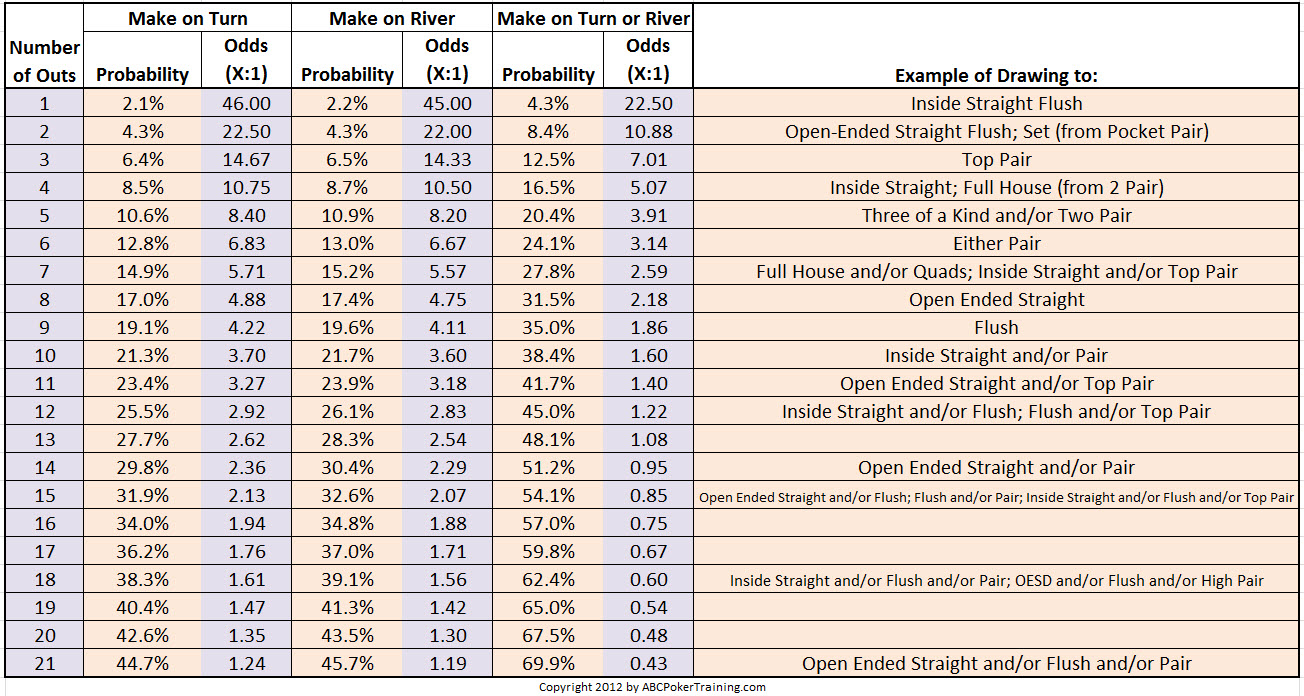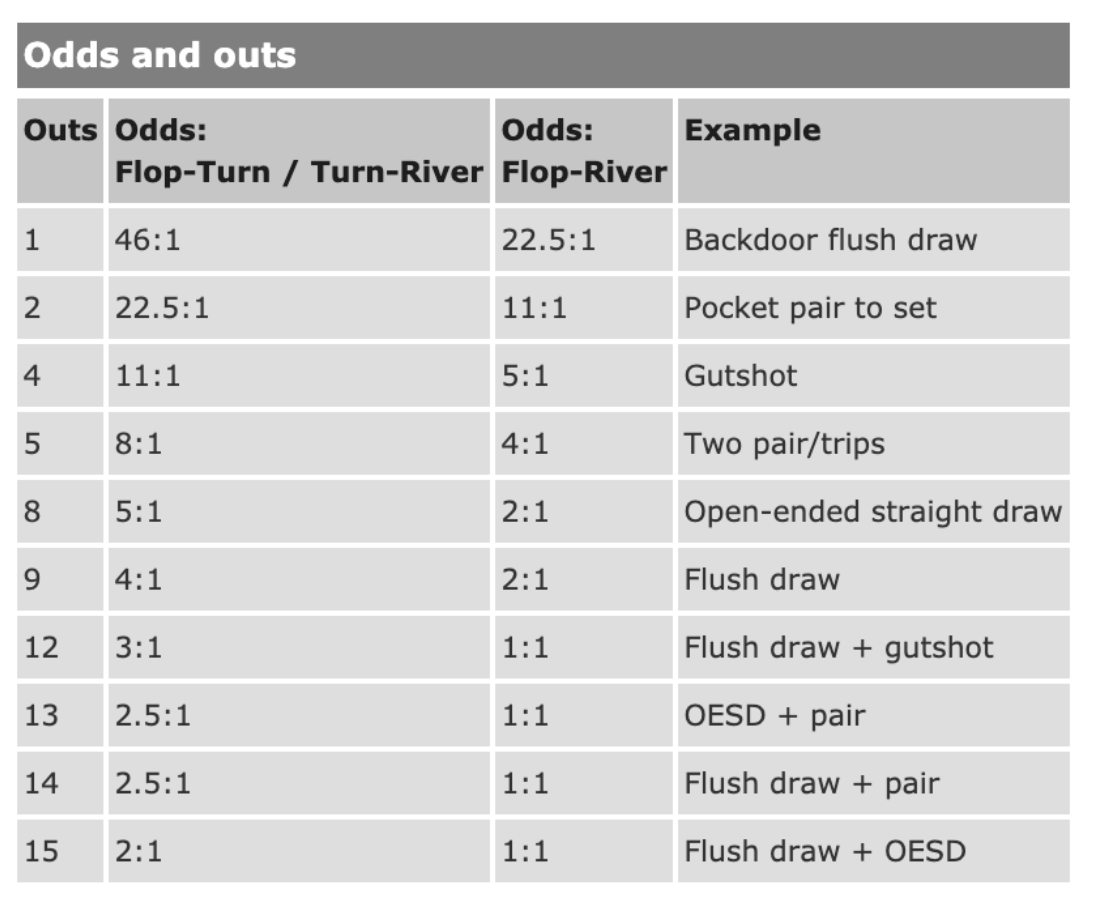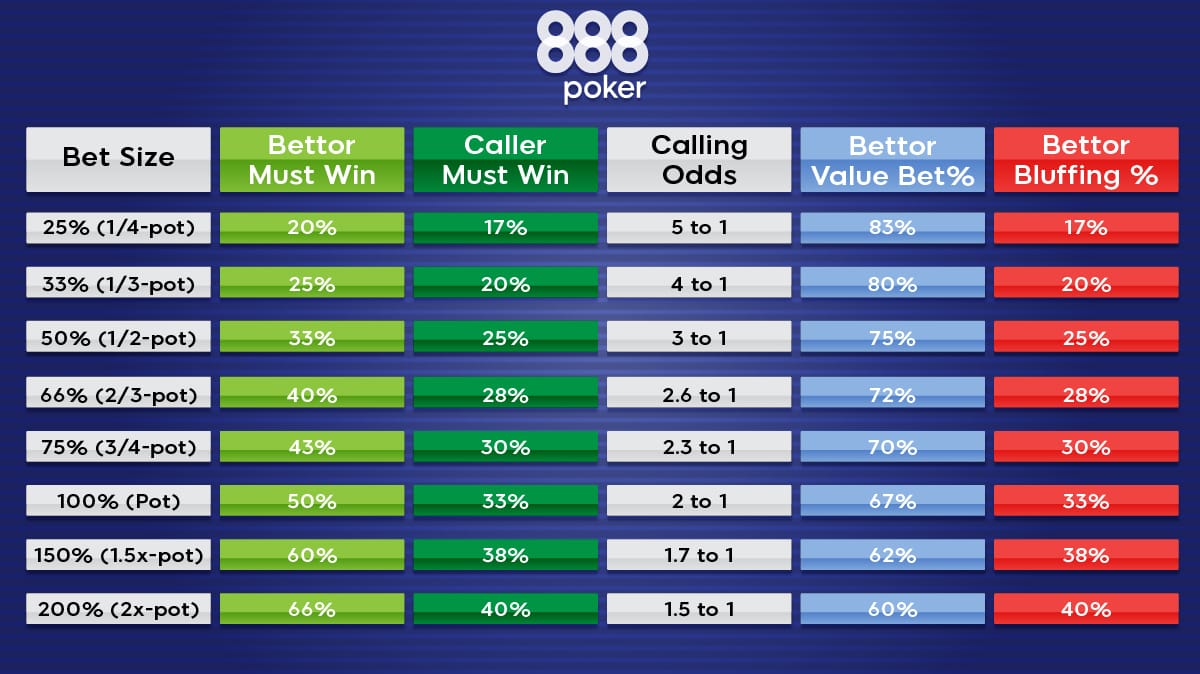Poker Counting Odds And Outs
- Poker Counting Odds And Outs Practice
- Poker Counting Odds And Outs Games
- Poker Counting Odds And Outs Printable
If you have an open-ended straight draw (8 outs), then the rule of thumb for the river would give you percentage of winning of 17% (2 x 8 + 1). Calculated exactly, the probability is 17.4%. In an all-in situation on the flop the rule of thumb gives you a chance of winning of 36% (4 x 9), calculated exactly it is 35%. Conclusion Outs and Odds in Poker. With 15 outs, 4 x 15 = 55 percent you'll complete that straight or flush with the next two draws. However, when you are calculating the odds that a single draw will improve your hand, you multiply the outs by two rather than 4. With 15 outs, 2 x 15 = 30 percent chance. You have an open-ended straight draw. This means 8 outs. 8 outs gives you 16% chance with one card to come. 16% chance is the same as 5:1 odds. Your Implied Odds are 8:1 and your odds for improving is 5:1. This is a clear call. Discounted Outs. To complicate things a bit there is something called discounted outs. This is used for situations where you are uncertain if your hand will improve to be the best if these cards hit.

When playing poker, you are often faced with the decision whether to call or fold to a bet. One way to determine whether to call is to see if the odds of winning the money in the pot (“pot odds”) equal or exceed the odds of you getting the cards you need for a winning hand (also called your ‘outs’). Quickly calculating whether the pot odds you face are favorable is essential to a long term winning strategy. In other words, only make a bet if it will pay off in the long run.
How to calculate card outs?
You must know how much money is in the pot in order to calculate pot odds. In a limit game, you can easily calculate this by counting the number of bets that are in the pot. For example, if there is $100 in the pot at a 10/20 game on the flop, then there are 10 bets in there. If you must call a single bet to remain in the hand, then the pot odds are 10:1. Online poker rooms have the amount of the pot displayed, so it is easier to just divide the amount you must bet into the pot size.
Preceding steps to calculate outs
The preceding steps are a quick method for determining outs on the next card. Other methods exist.
- Divide the number of cards unseen by the number of “outs” that you have. “Outs” are the cards remaining in the deck that will allow you to make a winning hand.
- Subtract 1.
- There must be at least that many bets in the pot (i.e., multiples of your bet) for a call.
- Example: Say you have 2 hearts. Two more hearts fall on the flop. There are now 47 unseen cards. You have 9 outs (9 out of 13 unseen hearts remaining in the deck) to make your flush on the next card.
- Divide 47 by 9 = 5.2
- Subtract 1 = 4.2
- There must be at least 4.2 bets in the pot for you to call a single bet.
- If you don’t get your card on the turn, you may be faced with repeating the process in the next round of betting. Remember that post-turn bets are usually larger than pre-turn bets.
| Hand | Goal | Outs |
|---|---|---|
| Pair | Set (Three of a kind) | 2 |
| Two pair | Full house | 4 |
| Inside straight | Straight | 4 |
| Open-ended straight | Straight | 8 |
| Four flush | Flush | 9 |
| Open-ended straight-flush draw | Straight, flush, or straight-flush | 15 |

Odds and outs
Some people advocate determining the number of outs required to make your hand using all future cards. For example, if you need one card for a flush, you actually have two draws to that card, not just one. Doing the math, you get 1.5:1 odds, so 1.5 bets would be your break even. Since you can be can be forced out on the next round, this is only true if there is no more betting. However, you need to estimate all future bets to get to that last card (yours and theirs), and that ratio needs to be 1.5 or more. It’s much harder to do this math on the fly, however, and usually requires you to memorize an ‘out’ list for different card combinations.
| Outs | Turn & River | River |
|---|---|---|
| 20 | 67% / 0.48:1 | 43% / 1.3:1 |
| 19 | 65% / 0.54:1 | 41% / 1.4:1 |
| 18 | 62% / 0.60:1 | 39% / 1.6:1 |
| 17 | 60% / 0.67:1 | 37% / 1.7:1 |
| 16 | 57% / 0.75:1 | 35% / 1.9.1 |
| 15 | 54% / 0.85:1 | 33% / 2.1:1 |
| 14 | 51% / 0.95:1 | 30% / 2.3:1 |
| 13 | 48% / 1.0:1 | 28% / 2.5:1 |
| 12 | 45% / 1.2:1 | 26% / 2.8:1 |
| 11 | 41% / 1.4:1 | 24% / 3.2:1 |
| 10 | 38% / 1.6:1 | 22% / 3.6:1 |
| 9 | 35% / 1.9:1 | 20% / 4.1:1 |
| 8 | 31% / 2.2:1 | 17% / 4.8:1 |
| 7 | 28% / 2.6:1 | 15% / 5.6:1 |
| 6 | 24% / 3:1 | 13% / 6.7:1 |
| 5 | 20% / 4:1 | 11% / 8.2:1 |
| 4 | 16% / 5:1 | 9% / 11:1 |
| 3 | 12% / 7:1 | 6% / 14:1 |
| 2 | 8% / 11:1 | 4% / 22:1 |
| 1 | 3% / 22:1 | 2% / 45:1 |
Poker Counting Odds And Outs Practice
Note that it mentions outs to a “winning hand”. There is no automatic system to determine what a “winning hand” is. Maybe that 3-of-a-kind could win. But maybe there’s 3 cards to a flush on the table. Experience will dictate what you consider a minimum strength hand to win.
The following table displays the outs needed versus the odds:
| 1 | 2 | 3 | 4 | 5 | 6 | 7 | 8 | 9 | 12 | 15 |
| 45 | 22 | 14 | 10 | 8 | 7 | 6 | 5 | 4 | 3 | 2 |
Formula for calculating hand odds in poker
(cards left – outs) / outs (which is the same as cards left / outs – 1)
- E.g.: (47-9) / 9 = 47 / 9 – 1 = 38 / 9 = 4.22 / 1

Poker Outs to Odds
To find your chance of improving a drawing hand based on the number of outs, use the following table:
| Outs | Turn Odds | River Odds | Turn+River Odds |
| 1 Out | 45.9-to-1 (2.13%) | 45.1-to-1 (2.17%) | 22.3-to-1 (4.26%) |
| 2 Outs | 22.5-to-1 (4.26%) | 22.0-to-1 (4.35%) | 10.9-to-1 (8.42%) |
| 3 Outs | 14.7-to-1 (6.38%) | 14.3-to-1 (6.52%) | 7.0-to-1 (12.49)% |
| 4 Outs | 10.8-to-1 (8.51%) | 10.5-to-1 (8.70%) | 5.1-to-1 (16.47%) |
| 5 Outs | 8.4-to-1 (10.64%) | 8.2-to-1 (10.87%) | 3.9-to-1 (20.35%) |
| 6 Outs | 6.8-to-1 (12.77%) | 6.7-to-1 (13.04%) | 3.2-to-1 (24.14%) |
| 7 Outs | 5.7-to-1 (14.89%) | 5.6-to-1 (15.22%) | 2.6-to-1 (27.84%) |
| 8 Outs | 4.9-to-1 (17.02%) | 4.8-to-1 (17.39%) | 2.2-to-1 (31.45%) |
| 9 Outs | 4.2-to-1 (19.15%) | 4.1-to-1 (19.57%) | 1.9-to-1 (34.97%) |
| 10 Outs | 3.7-to-1 (21.28%) | 3.6-to-1 (21.74%) | 1.6-to-1 (38.39%) |
| 11 Outs | 3.3-to-1 (23.40%) | 3.2-to-1 (23.91%) | 1.4-to-1 (41.72%) |
| 12 Outs | 2.9-to-1 (25.53%) | 2.8-to-1 (26.09%) | 1.2-to-1 (44.96%) |
| 13 Outs | 2.6-to-1 (27.66%) | 2.5-to-1 (28.26%) | 1.1-to-1 (48.10%) |
| 14 Outs | 2.4-to-1 (29.79%) | 2.3-to-1 (30.43%) | 0.95-to-1 (51.16%) |
| 15 Outs | 2.1-to-1 (31.91%) | 2.1-to-1 (32.61%) | 0.85-to-1 (54.12%) |
| 16 Outs | 1.9-to-1 (34.04%) | 1.9-to-1 (34.78%) | 0.75-to-1 (56.98%) |
| 17 Outs | 1.8-to-1 (36.17%) | 1.7-to-1 (36.96%) | 0.67-to-1 (59.76%) |
| 18 Outs | 1.6-to-1 (38.30%) | 1.6-to-1 (39.13%) | 0.60-to-1 (62.44%) |
| 19 Outs | 1.5-to-1 (40.43%) | 1.4-to-1 (41.30%) | 0.54-to-1 (65.03%) |
| 20 Outs | 1.3-to-1 (42.55%) | 1.3-to-1 (43.48%) | 0.48-to-1 (67.53%) |
| 21 Outs | 1.2-to-1 (44.68%) | 1.2-to-1 (45.65%) | 0.43-to-1 (69.94%) |
| 22 Outs | 1.1-to-1 (46.81%) | 1.1-to-1 (47.83%) | 0.38-to-1 (72.25%) |
Poker Counting Odds And Outs Games
| Accuracy | Turn | River | Turn+River | Comments |
| Excellent | Outs times 2.13% | Outs times 2.17% | *Turn odds plus River odds minus Turn odds times River odds | More accurate than you'll ever need |
| Very Good | Outs times 2-1/8% | Outs times 2-1/6% | **Outs times 4%, minus (Outs - 8) if 9 or more Outs | As accurate as you'll ever need |
| Good | Outs times 2%, plus 1% if 5+ Outs, plus 2% if 13+ Outs | Same as Turn | **Outs times 4%, minus (Outs - 8) if 9 or more Outs | The easiest reasonable approximation |
| Bad | Outs times 2% plus 1% | Same as Turn | Outs times 4% | Not good if low or high numbers of outs |
* For example, using the Good approximation, if you have 9 Outs, then you have a 19% chance on the turn, a 19% chance on the river, and a 38% minus 19% of 19% (close to 20% of 20%, which is 4%) equals a 34% chance on the turn and river combined.
** From David Solomon, mentioned in Harrington on Hold 'em: Volume 2.
